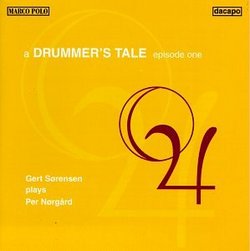| All Artists: Gert Sorensen, Per Norgard Title: Plays Per Norgard / A Drummer's Tale Members Wishing: 1 Total Copies: 0 Label: Marco Polo Release Date: 11/21/1995 Genre: Classical Style: Chamber Music Number of Discs: 2 SwapaCD Credits: 2 UPC: 730099972420 |
Search - Gert Sorensen, Per Norgard :: Plays Per Norgard / A Drummer's Tale
 | Gert Sorensen, Per Norgard Plays Per Norgard / A Drummer's Tale Genre: Classical
|
Larger Image |
CD DetailsSimilar CDs |
CD ReviewsNorgard's percussion music has much appeal with their intere Christopher Culver | 10/31/2009 (4 out of 5 stars) "This Dacapo release from 1995 features, over two CDs, Gert Sorensen playing six percussion pieces by the great Danish composer Per Norgard, with an unusual bonus track. Sorensen has long been a prominent musician in Danish musical circles for his collaborations with a number of figures and his interest in integrating percussion and electronics. The music here was recorded in his home studio with the help of Palle Mikkelborg, that famous Nordic jazzman.
Norgard's first solo percussion piece was "Waves" (1968), written at the height of his psychadelic phase. In this 20-minute long work, the drummer plays repeating patterns where ever so gradually certain notes are emphasized while others are dropped. This is a hypnotic piece, slow and undramatic but steadily vaster. It's also useful for understanding Norgard's later music, as the "Waves technique" appears in such works as "I Ching" and the Symphony No. 5. "Isternia" (1979) was originally written for cimbalom, but the untimely death of the dedicatee obscured the work for some years. Portions of it were arranged for flute and harp as "Sonora", but eventually Gert Sorensen made the transcription for marimba we hear on this disc. This work is based on phrasings that cut off before they would naturally finish. It's a lovely work, especially for marimba, but it doesn't seem as deep to me as other Norgard. When Per Norgard wrote "I Ching" (1983), he was exploring extreme shifts between idyll and catastrophe, inspired by the schizophrenic Swiss artist Adolf Wolfli. It features several of the technical discoveries that Norgard had made to date, including the infinity series (a method of generating melody with fractal-like self-similarity) and novel accelerandi. Each of the four movements of "I Ching" takes its title from a symbol in the Chinese classic. "Thunder Repeated: The Image of Shock" develops as birdsong in pitched percussion over talking drums, then peters out into a slow melody on the gongs. The brief second movement, "The Taming Power of the Small" is mainly concerted with glissandi. Subtitled "9 Sounds/'9' Sounds", it features a brief hommage to the Beatles which might sound hokey to some, but fits in with the Wolflian world view. The third movement, "The Gentle, the Penetrating" is also short. Slow and highly melodic, it is played mainly on the kalimba and one of the most simply beautiful things that Norgard has ever written. The fourth movement, however, is most impressive, for in "Towards Completion: Fire over Water" the performer plays a two-tone infinity series at extremely fast tempo, then makes the music seem faster still through the "Waves" technique, and ends by improvising for a few minutes. In judging this performance, I have the curious complaint that Sorensen plays too well, all cool and self-assured with this virtuoso score. Part of the thrill of dedicatee Gert Mortensen's performance on a BIS disc is hearing the solo really *work* on the piece. "Energy Fields Forever" for percussion and tape (1985) is one of the first pieces in Norgard's "multidimensional" period, sharing concerns with his first violin concerto "Helle Nacht" of the same era. Three rhythmic layers at played at the same time, with interference arising between them and foreground and background constantly changing, yet remarkably they never completely obscure each other. The tape part which comes in halfway shows how the effect is sustained even as things become furiously fast. Towards the end of the piece a waltz melody appears, one of the only decipherable musical writings of Adolf Wolfli. "Nemo Dynamo" for percussion and electronics (1991) highlights the differences between man and machine. Here the computer part is blazingly fast, but inflexible, playing a two-tone infinity series in a predictable fashion. The human being is slower, but can use his knowledge of the series to improvise in all kinds of different directions. The rhythms here are infections; I listen to "Nemo Dynamo" in the same contexts as pop music. "Bulan" for two percussionists (1990) is a series of variations on material from the obscure Danish composer Poul Dovsing Olsen's work "The Planets", specifically the Moon movement. Mikkelborg joins Sorensen here, but their playing seems more like noodling than the rigor one comes to expect from Norgard. The set is filled out with "Circus City", a 30-minute improvisation created by Per Norgard himself at a Jupiter 8 synthesizer. This is a curiosity--it rarely calls me back compared to Norgard's through-composed music. Nonetheless, it can be fascinating to hear Norgard follow his instincts." |

 Track Listings (6) - Disc #1
Track Listings (6) - Disc #1


![So you'd like to save the world [Single-CD]](https://nationalbookswap.com/cd//m/48/3548/533548.jpg)
